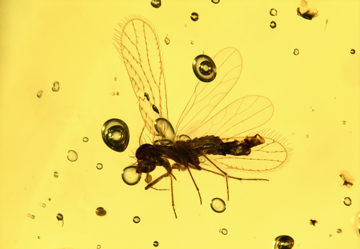Abstract
The extinct genus †Clidicostigus Jałoszyński, Brunke & Bai, 2017 of the scydmaenine supertribe Mastigitae is a small group comprising three species from late Albian to early Cenomanian amber of northern Myanmar (Ross, 2019). Members are characterized by the presence of distinct longitudinal striae of the elytra, the elongate median mesoventral carina, and the asymmetrical, approximately boomerang-shaped maxillary palpi (Jałoszyński 2018). Based on the exaggerated elongate spine-like setae of the first two antennomeres of †Baltostigus Jałoszyński, 2016 (Eocene Baltic amber) and †Clidicostigus, Jałoszyński (2016) and Yin et al. (2017, 2018a) postulated that the spiny basal part of the antennae may function as setal cages used for hunting fast-moving preys, e.g., springtails. However, this hypothesis was later falsified by Jałoszyński (2018) based on observations of extant species, which in contrast possess much shorter and thinner setae of the antennae, and act more like opportunistic scavengers. Except for the debatable behavior regarding the function of the antennae of †Clidicostigus, the biology of this genus is otherwise largely unknown. Here we report the first case of aggregation behaviour of †C. arachnipes in Burmese amber.
References
Chhibber, H. L., 1934. The mineral resources of Burma. MacMillan, London, 320 pp.
Cruickshank, R. D. & Ko, K. (2003) Geology of an amber locality in the Hukawng Valley, northern Myanmar. Journal of Asian Earth Sciences, 21, 441–455.
https://doi.org/10.1016/S1367-9120(02)00044-5
Grimaldi, D.A., Engel, M.S. & Nascimbene, P.C. (2002) Fossiliferous Cretaceous amber from Myanmar (Burma): its rediscovery, biotic diversity, and paleontological significance. American Museum Novitates, 3361, 1–72.
https://doi.org/10.1206/0003-0082(2002)361<0001:FCAFMB>2.0.CO;2
Grimaldi, D.A. & Ross, A.J. (2017) Extraordinary Lagerstätten in amber, with particular reference to the Cretaceous of Burma. In: Fraser, N.C., Sues, H.D. (Eds.), Terrestrial conservation Lagerstätten: Windows into the evolution of life on land. Dunedin Academic Press, Edinburgh, pp. 287–342.
Jałoszyński, P. (2016) A new Eocene genus of ant-like stone beetles sheds new light on the evolution of Mastigini. Journal of Paleontology, 89, 1056–1067.
https://doi.org/10.1017/jpa.2015.75
Jałoszyński, P., Brunke, A.J., Metscher, B., Zhang, W.W. & Bai, M. (2017) Clidicostigus gen.nov., the first Mesozoic genus of Mastigini (Coleoptera: Staphylinidae: Scydmaeninae) from Cenomanian Burmese amber. Cretaceous Research, 72, 110–116.
https://doi.org/10.1016/j.cretres.2016.12.022
Jałoszyński, P., Brunke, A.J., Yamamoto, S. & Takahashi, Y. (2018) Evolution of Mastigitae: Mesozoic and Cenozoic fossils crucial for reclassification of extant tribes (Coleoptera: Staphylinidae: Scydmaeninae). Zoological Journal of the Linnean Society, 184, 623–652.
https://doi.org/10.1093/zoolinnean/zly010
Kania, I., Wang, B. & Szwedo, J. (2015) Dicranoptycha Osten Sacken, 1860 (Diptera, Limoniidae) from the earliest Cenomanian Burmese amber. Cretaceous Research, 52 (Part B), 522–530.
https://doi.org/10.1016/j.cretres.2014.03.002
Mao, Y.Y., Liang, K., Su, Y.T., Li, J.G., Rao, X., Zhang, H., Xia, F.Y., Fu, Y.Z., Cai, C.Y. & Huang, D.Y. (2018). Various amberground marine animals on Burmese amber with discussions on its age. Palaeoentomology, 1, 91–103.
https://doi.org/10.11646/palaeoentomology.1.1.11
Rasnitsyn, A.P., Bashkuev, A.S., Kopylov, D.S., Lukashevich, E.D., Ponomarenko, A.G., Popov, Y.A., Rasnitsyn, D.A., Ryzhkova, O.V., Sidorchuk, E.A., Sukatsheva, I.D. & Vorontsov, D.D. (2016) Sequence and scale of changes in the terrestrial biota during the Cretaceous (based on materials from fossil resins). Cretaceous Research, 61, 234–255.
https://doi.org/10.1016/j.cretres.2015.12.025
Ross, A.J., Mellish, C., Crighton, B., 2010. Burmese amber. In: Penney, D. (Ed.), Biodiversity of fossils in amber from the major world deposits. Siri Scientific Press, Manchester, pp. 208–235.
Shi, G.H., Grimaldi, D.A., Harlow, G.E., Wang, J., Wang, J., Yang, M.C., Lei, W.Y., Li, Q.L. & Li, X.H. (2012) Age constraint on Burmese amber based on U–Pb dating of zircons. Cretaceous Research, 37, 155−163.
https://doi.org/10.1016/j.cretres.2012.03.014
Yin, Z.W., Cai, C.Y. & Huang, D.Y. (2018a). A potentially diverse fauna of springtail-hunting scydmaenines during the late Mesozoic (Coleoptera, Staphylinidae, Scydmaeninae). Cretaceous Research, 90, 163–167.
https://doi.org/10.1016/j.cretres.2018.04.020
Yin, Z.W., Cai, C.Y. & Huang, D.Y. (2018b) Last major gap in scydmaenine evolution filled (Coleoptera: Staphylinidae). Cretaceous Research, 84, 62–68.
https://doi.org/10.1016/j.cretres.2017.10.026
Yin, Z.W., Cai, C.Y., Huang, D.Y. & Li, L.Z. (2017). Specialized adaptations for springtail predation in Mesozoic beetles. Scientific Reports, 7, article number: 98.

